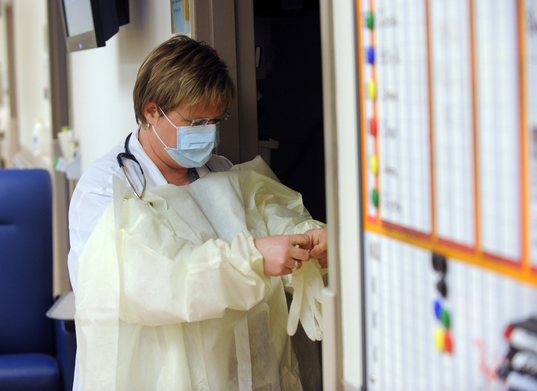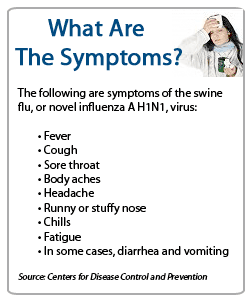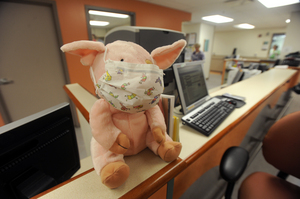Ann Arbor area hospitals, physicians respond to influx of swine flu patients
The vast majority of those sickened by swine flu in Washtenaw County will never meet Dr. Lena Napolitano at the University of Michigan Health System.
That's because, for most people, the highly contagious flu virus will never require a trip to the doctor's office.
But for an estimated 5 percent of the population, the Centers for Disease Control and Prevention along with local hospitals say it’s been leading to trips to the emergency department and hospitalizations.

Pediatrician, Dr. Anne Vanden Belt, prepares to see a patient with H1N1 influenza, Wednesday afternoon in the St. Joseph Mercy Hospital pediatric emergency room. The ER at St. Joe's has seen an increase in flu-related visits recently. Some legitimate, some due to the paranoia surrounding the H1N1 virus.
Lon Horwedel | AnnArbor.com
And for a fraction of that population, the flu has led to extremely serious infections that can cause failure of a patient’s lungs.
These are the people who have been seeing Napolitano, chief of acute-care surgery at the U-M. She is among the physicians treating the “worst of the worst” cases of H1N1 complications in the region and has been alarmed by the severity of those cases.
She and local health officials have been carefully watching the pandemic play out in the Ann Area area. They say that while most local residents are not becoming severely ill from the virus, physician offices and hospitals have had to rely on some of their emergency planning to deal with an influx of those who have.

Swine flu symptoms
Flu activity in the county
Local health officials say their alarm has to do with the unpredictability of who might be severely sickened by the virus, the severity of those potential complications and how easily it has been spreading through the population.
And the Ann Arbor area has been ripe with flu in recent weeks.
Several times already this year, county epidemiologist Laura Bauman has had to increase the scale of the chart on which she reports local flu statistics after the number of reported flu cases kept doubling.
“I’ve never seen levels like this,” Bauman said.
There were more than 80 lab-confirmed flu cases, presumably from the H1N1 virus, in the county the week ending Oct. 31. More than 70 out of every 1000 students
in the county were out sick with respiratory illnesses that week.
This time of year, there are usually few, if any, confirmed cases of any kind of flu. Peaks for children out sick with respiratory illness in recent years have gotten as high as nearly 35 per 1,000 kids, but those peaks don’t general occur until January or February.
So far, there are no reported deaths of Washtenaw County residents due to the swine flu, but local hospitals have had patients die from elsewhere. There have been 31 hospitalizations of county residents through the week of Oct. 31.
At both U-M and St. Joseph Mercy Health System, the flu activity in the pediatric units have been significant compared to normal volumes.
At St. Joseph Mercy Hospital's Emergency Department, nurse manager Jennifer Dunn said there have been huge influxes of patients - largely in pediatrics - coming in with flu-like symptoms.
Children are more likely to have an underlying condition like asthma and need breathing treatments. Adults are more likely to come in with gastrointestinal symptoms, needing treatment for dehydration, she said.
The illness seems to be creeping more into adult populations in recent weeks, said Shon Dwyer, who's been leading U-M's logistics planning for H1N1.
"We are at the peak right now," Dwyer said.
At least, experts think so since it's impossible to really know if a population is experiencing the peak spread of an illness until its over.
"The majority of cases are mild, the data bears that out. But it is still deadly and unpredictable,” Dwyer said.
The rate in which the illness has spread led all county hospitals to institute new visitor guidelines limiting the age and the number of visitors allowed to see patients at a single time.
The hospitals have been vaccinating the highest priority staff members and patients. So far, there have been no documented cases of workers getting the flu from a patient at either hospital.
But vaccination has been slower going than hoped. The county has had to ration its first shipments of vaccine after reporting in late October it had only received about 30 percent of what it had expected by that point.
The lack of vaccine early on has led to frustration for many local residents and health care providers.
Now that vaccine is slowly trickling in, the county is planning its third vaccination clinic for a more priority groups this Saturday in a race to get the vaccine to more residents.

A stuffed toy pig wearing a protective mask sits on the desk of the nurses station to lighten the mood in St. Joseph Mercy Hospital's pediatric emergency room.
Lon Horwedel | AnnArbor.com
Local primary care offices, emergency rooms flooded with questions
Local doctors' offices, and more importantly their telephone lines, have been inundated with questions and concerns. For instance, in the last week of October, U-M primary care doctors saw about 600 patients.
Hospitals have been encouraging those who become ill or have ill children to call for advice when possible to avoid spreading the flu in physician waiting rooms or emergency rooms.
Residents seem to be following that recommendation in varying degrees. Most doctors offices have set up a protocol to handle questions over the phone and remotely offer suggestions of how to care for someone who does have the flu and the warning signs of potential complications to look out for.
At St. Joseph Mercy Health System, there have been issues with patients with relatively mild cases of the flu coming into the emergency room, said Russ Olmsted, epidemiologist in infection control services at Saint Joseph Mercy Health System.
“That … makes it more difficult for providers to see the people who need to be seen,” he said.
The number of people presenting or being admitted with flu-like illness has been up and remained quite steady in recent weeks. In the past month, the hospital saw 66 inpatients with flu-like illness and 20 of those cases were H1N1-confirmed.
There are currently 13 people at St. Joseph Mercy Hospital in Ann Arbor hospitalized because they have the H1N1 flu virus. Two of them are in the Intensive Care Unit.
U-M's emergency room had been seeing, on average, 30 to 50 patients per day with flu-like illness in the past month. On average, there are about 30 patients a day hospitalized for precautions or treatment for flu-like illness.
For the most part, adults and kids alike, are winding up in the emergency room with respiratory issues and dehydration. But it's been particularly high in pediatrics.
"Activity in pediatrics is significant in relation to the normal volumes," Dwyer said.
Most of them have some sort of chronic underlying health condition, Dwyer said. They are being treated with inhalers or other breathing treatments to open up their airways and being hydrated either orally or using an IV.
Those who meet the guidelines are being offered Tamiful, Dwyer said.
U-M's emergency room back-up was tested last month for about five days when it had to create an overflow pediatric emergency room - run by primary care medical staff - to handle pediatric cases of the flu.
It's been the pediatric departments that have been most greatly impacted.
ICU plans being reworked
Among that small minority of patients who do end up in the ICU, the prognosis does not look good.
It only happens in about 1 percent of the population that gets the flu virus, but some who become ill with the H1N1 virus end up developing a life threatening respiratory condition called acute respiratory distress syndrome.
The syndrome caused when the lungs fail to work properly can lead to low blood oxygen levels and organ failure. About 20 percent to 30 percent of the patients who do end up there due to H1N1 complications do not survive.
“That means one out of every three or five (patients hospitalized in the ICU from H1N1) dies despite our aggressive therapy,” Napolitano said.
Treatments doctors try on patients in the ICU includes the use of inhaled nitric oxide, ventilators, oscillator’s and even flipping the patient onto their stomachs to aid breathing.
About half of the ICU is taken up by patients with H1N1, Napolitano said during an interview last week. There hasn't been a strain on equipment like the ventilators yet.
Survival Flight helicopters are now equipped with ventilators and crews are now trained to begin treatment for respiratory problems en route to the hospital.
A few weeks ago, local hospitals were starting to get concerned about whether the local capacity of pediatric ICU bed would be enough to handle the small, but growing number of patients who needed advanced medical help.
U-M’s C.S. Mott Children’s Hospital is one of the only places in the region that has what is called the extracorporeal membrane oxygenation, or ECMO machine which has been used to treat some of the worst cases of the flu.
Regional hospitals were considering shifting some of U-M’s less intensive ICU cases to their facilities to free up room for the most serious cases of complications due to H1N1, Olmsted said.
It doesn’t look like that will be necessary at this point, but it’s an idea that’s stayed on the table as hospitals team up to figure out ways to best handle those cases.
The deaths from H1N1 raise so many questions from devastated family members who, many who may have gotten the flu themselves, want to know why their loved one got as sick as they did. It’s a frustrating part of Napolitano’s job.
“We don’t have answers for them at the current time,” she said.
Health experts around the world have been scrambling to best define who is at the most risk for developing complications and understand why.
Napolitano herself published a report in the Centers for Disease Control and Prevention’s Morbidity and Mortality Weekly report earlier this year on the believed link between obesity and H1N1 flu risks. The report was based on 10 swine flu patients. Of the group, nine were obese and seven of those patients were morbidly obese.
“It has something to do with the lungs’ immune system not being able to effectively fight this,” or in some cases, to overreact to the infection, she said.
She recently had a 28-year-old male patient die from H1N1 complications.
It reminds her again what makes the H1N1 virus so different from the seasonal flu, even though it has similar mortality and hospitalization rates: Unlike the typical flu that puts the elderly and the already sick at greatest risk, it’s young, and healthy people who seem to be dying from this.
“A 28-year old male who is otherwise healthy, with no underlying conditions, is really striking,” Napolitano said.
Tina Reed covers health and the environment for AnnArbor.com. You can reach her at tinareed@annarbor.com, call her at 734-623-2535 or find her on Twitter @TreedinAA.


Comments
eagleman
Fri, Nov 13, 2009 : 7:08 p.m.
Atticus and aaman make some good points. But the faith in government is a little excessive. The "good" form of governance people most offen reference is either local or essnetially left to the experts--the military. But even in the military we see waste, corruption, and incompetence. People who fear corporations, but trust government simply are not thinking it through. What is a government than a more powerful version of a corporation? To the government, we are but a number. I don't advocate the paranoid stance of OverTaxed, but a realistic view. Government is like medication--its good in the proper does, but can kill you if you overdo it.
aaman
Thu, Nov 12, 2009 : 3:06 p.m.
Atticus F - I agree with your sentiment. How about privatizing the roads, and the airports. For that matter if we entirely privatize the hospitals the ER's can refuse admission to people who show up without insurance. That will save them a lot of money. The may have to pay extra private security when sick people without insurance demand to be treated. Oh and while we are at it let's privatize all first responders. The call to 911 would be a toll call and the operator would say "What's your problem?" Answer is "my house is on fire" or "someone is breaking into my house" or "there has been an auto accident and this person is unconscious." Operator says "Give me your insurance number." Caller "I don't have any." Operator - click, hangs up.
aaman
Thu, Nov 12, 2009 : 2:58 p.m.
Overtaxed...just curious. What do you think of Medicare? Those that are on it praise it at up to 90%. Just another failed government program that does not satisfy 100% of people I guess. Do you not think meds are being rationed now? How exactly do the 40 million people without insurance get meds? Many of them wind up skipping every other day or cutting their pills in half which impacts the effect of the med. Then they come to the ER when things get bad. Could have saved $ by providing a base level of care to everyone. The only reason there are "not enough" doctors is that the profession rigidly controls medical school size so there are not more graduating. It is strictly a monoplistic system that keeps the number of doctors down so that they can demand more money.
Atticus F.
Thu, Nov 12, 2009 : 2:52 p.m.
By the way if you haven't notice, we have 40 million people in this country that are already "going without".
Atticus F.
Thu, Nov 12, 2009 : 2:50 p.m.
Overtaxed, the simple fact is that these are being passed out based on need. And there is a shortage because it's a new vaccine, not because of some government conspiricy. BTW, If you can read this, thank a 'socialized' public school system... Paid for by tax dollars. Maybe you think this would be a stronger country if we had no 'socialized' school system, and 80% of our poputation were illiterate. While your at it, why dont you call for a privitized millitary? Also, why should you have a socialist police force or fire dept? I'm sure you would rather pay premiums to Blue Cross in order to insure that you have access to a private police force.
OverTaxed
Thu, Nov 12, 2009 : 1:14 p.m.
I want to get a swine flu shot, but do not meet the government requirements. Get used to rationing like this with national healthcare. When there is not enough doctors, meds, etc, people will go without. Down with the socialists!
Kristin Judge
Thu, Nov 12, 2009 : 12:45 p.m.
There will be another H1N1 Vaccination Clinic this Saturday at Pioneer High School from 9am-2pm. The priority groups for Saturdays vaccination clinic, according to CDC guidelines are: Pregnant women Household and caregiver contacts of infants younger than 6 months Health care and emergency medical services personnel who provide direct patient care Children and young adults 6 months through 24 years of age Individuals 25 to 64 years old who have medical conditions that put them at a higher risk of influenza- related complications Examples of underling medical conditions include: chronic lung disease, weakened immune systems, cancer, diabetes, kidney or liver disorders, cardiovascular disease and other conditions. Visit the Washtenaw County Public Health Website or call their phone for more information. 734-544-6759 or http://www.ewashtenaw.org/government/departments/public_health